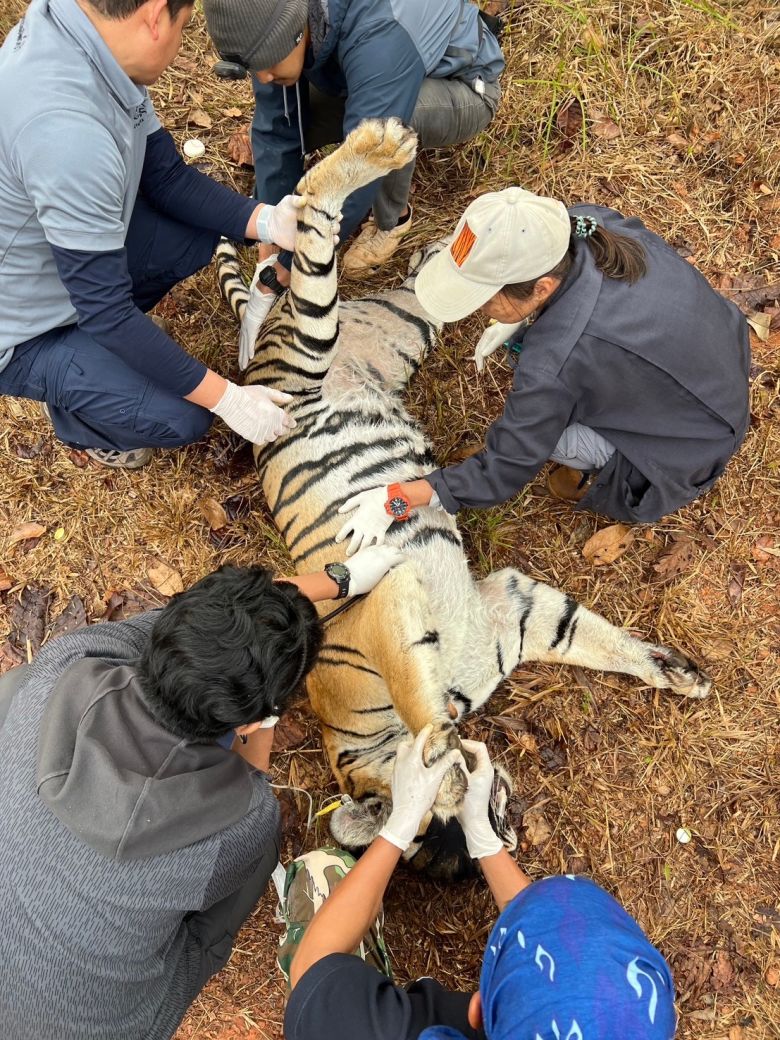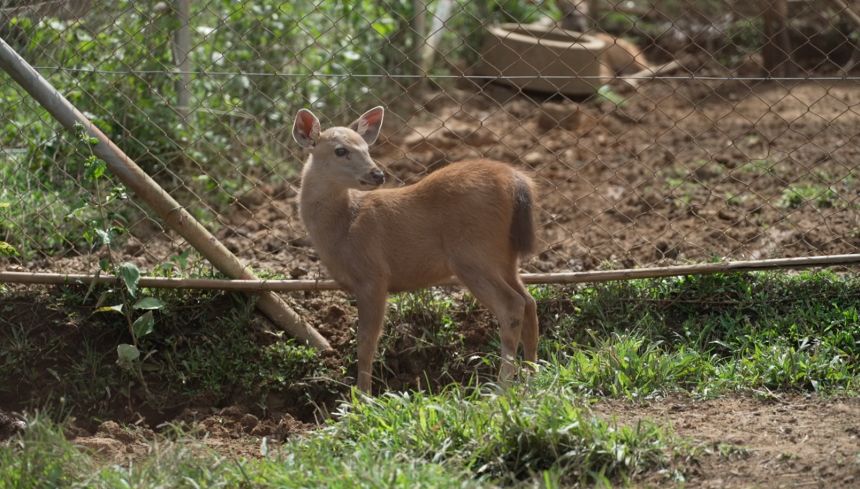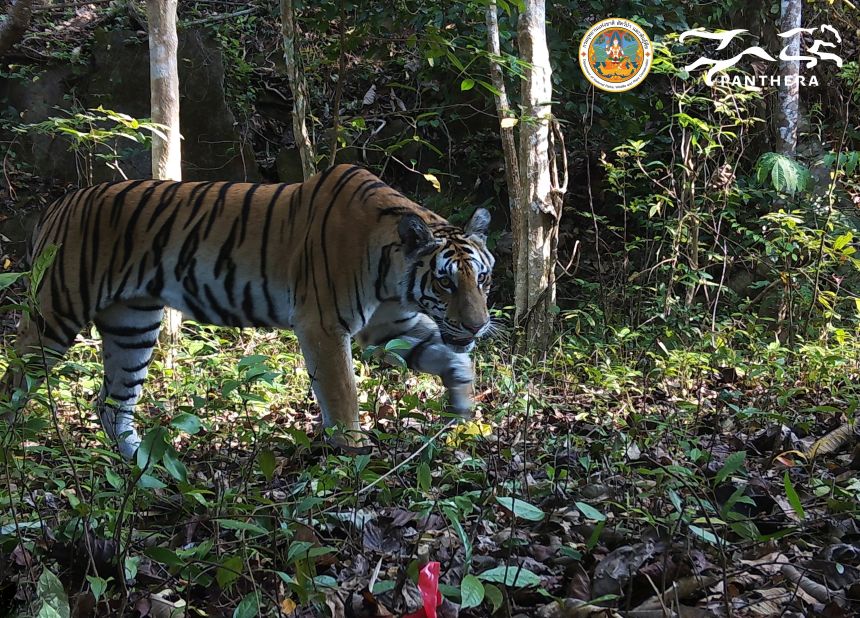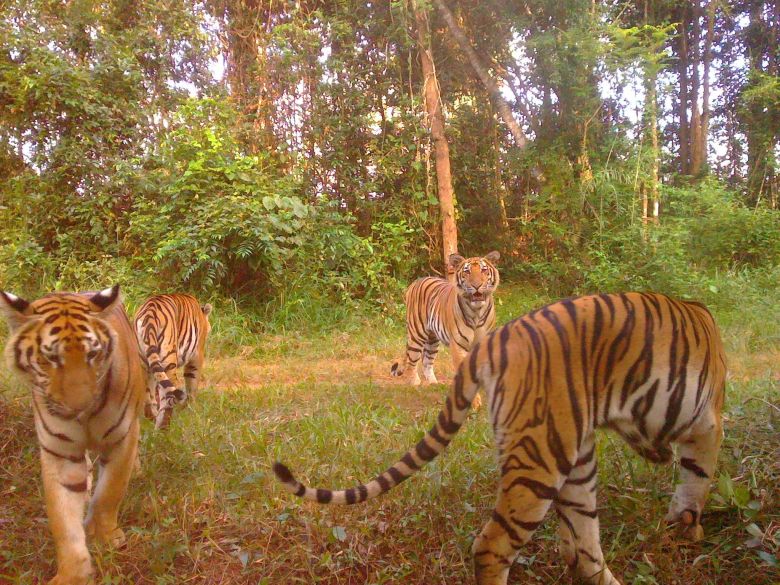Deep in the evergreen jungle of Thailand’s Dong Phayayen-Khao Yai Forest Complex (DPKY-FC), a spring-loaded trap is waiting to catch a tiger.
No one knows exactly when the animal will return to mark its scent again — in a week or two, maybe longer — so the trap must be checked three times a day.
Luckily for the big cat, this trap isn’t set by poachers: it’s the work of conservationists, trying to save the species.
“It’s a lot of time and effort to trap a tiger,” says Rattapan Pattanarangsan, a conservation program manager at the nonprofit Panthera Thailand. But with just 20 to 30 tigers roaming the 6,000-square-kilometer (2,317-square-mile) DPKY-FC, this effort is essential to protecting the “last of the last” of its Indochinese tigers, a population that was only discovered in the early 2000s.
Thailand is a rare example of tiger recovery in Southeast Asia, but most of that has taken place in the country’s Western Forest Complex, where tiger populations more than tripled between 2007 and 2023.
Meanwhile, DPKY-FC’s tiger population has remained stagnant, despite ample room for expansion.
“If the forest is in good condition, the population should increase,” says Pattanarangsan, adding that some areas have had no tiger sightings for over a decade.
To work out why the tiger population isn’t growing, conservationists decided to tag three tigers with GPS collars earlier this year.
“With camera trapping, we have primary data — how many of them are here and there. But we want to have deeper data, to know the tiger ecology: how they disperse, how they live, how or what they eat,” says Pattanarangsan.
The collars, fitted in early 2025, are already revealing new insights into tiger behavior — and offering clues to help conservationists secure their future.
While GPS collars have been used to track tigers before, such as in big cat relocations and population counts, the technology is new to DPKY-FC.
The project, spearheaded by Thailand’s Department of National Parks, Wildlife and Plant Conservation, and Panthera, collaborated with conservationists from the Western Forest Complex, Thailand’s largest conservation area and home to the majority of the nation’s tiger population, who have been catching and collaring tigers using nonharmful snare traps since 2005.
Upon capture, the tiger is sedated by a veterinarian so the team can attach the collar and collect samples from the animal. All in all, it takes less than an hour, says Pattanarangsan.


The team at DPKY-FC chose three tigers to trial the collars on: an adult male, named Srikosa, and sub-adult sisters, Chantra and Pianporn.
The lightweight collars have a battery life of up to two years, and record coordinates every hour, transmitted via satellite. But in dense jungle, transmission isn’t always successful, so data is also stored in the collar’s hard drive for download later. When the battery is nearly depleted, the collar detaches automatically and sends a final signal for retrieval.
Using these location points, the team was able to track each tiger’s home range, movement patterns and kill sites — which revealed the remains of “strange prey,” says Pattanarangsan.

Tigers typically hunt large animals such as cow-like banteng, gaur or sambar deer, which can reach up to 350 kilograms (772 pounds). But in DPKY-FC, the three tigers have been eating smaller mammals like wild pigs and muntjac deer, some weighing as little as 10 kilograms (22 pounds).
This reinforces the findings of a study published last year, which highlighted the limited number of large prey, says Pattanarangsan: “That (behavior) is very strange, and could reflect the scarcity of prey.”
One of the tigers, Chantra, whose name means moon — chosen because she was fitted with her collar on a Buddhist holy day under a full moon — is taking odd eating habits to a new level.
While the other two tigers preyed on smaller ungulates (hoofed animals like cows and deer), one of Chantra’s primary prey species is the hog badger.

Researchers also found evidence of opportunistic snacking on soft-shell turtle and water monitors, the first record of this kind of prey for wild tigers in Thailand, said Somporn Pakpien, chief of the DPKY Wildlife Research Station, in an email.
Chantra’s undiscerning taste is just one of her many quirks. Despite leaving her mother’s care first, she’s smaller in size than her sister Pianporn, and her home range is just 24 square kilometers (9.3 square miles), less than half the size of her sister’s.
“She could be smaller because she’s less selective; she just eats everything,” says Pattanarangsan. Tigers with larger home ranges are likely “more selective,” resulting in larger prey and a larger body size, which makes hunting for bigger meals easier, he adds.
Chantra also has a kink in her tail, which in other cat species, can be an indication of genetic issues from inbreeding, says Pattanarangsan, adding that the implications of this in tigers is still unknown.
“If we look at the whole population of 20 or 30 animals, we have quite a small gene diversity, so we should be concerned about this,” he adds.
As the team at DPKY-FC learn more about the tiger’s eating habits, they’re working hard to protect its habitat, too.
“On the left side of the DPKY, mainly the Khao-Yai National Park, we call it the empty forest,” because there are no tigers living there, says Pattanarangsan.


The forest complex plans to conduct a threat analysis with a wildlife crime expert in the next few months to address other issues that may be limiting the tiger population, such as poaching of tigers or their prey, or the impact of infrastructure projects that bisect the habitat, like Highway 304 and a proposed dam, which Pattanarangsan believes poses a huge risk by enabling “easy access” for hunters.
“We can have a better understanding of what kind of threats are coming, and what to do,” he says, adding that if the park can reduce the threat levels, “the prey population will be higher, also the tiger population will be higher.”
While the GPS collaring project is still in its early stages, Pattanarangsan is optimistic that the information gleaned so far can help the team at DPKY-FC focus their efforts to help tiger numbers grow.
“In this first year, we’re learning how to do it,” he says, adding that they hope to get more funding to eventually “understand the whole population.”

